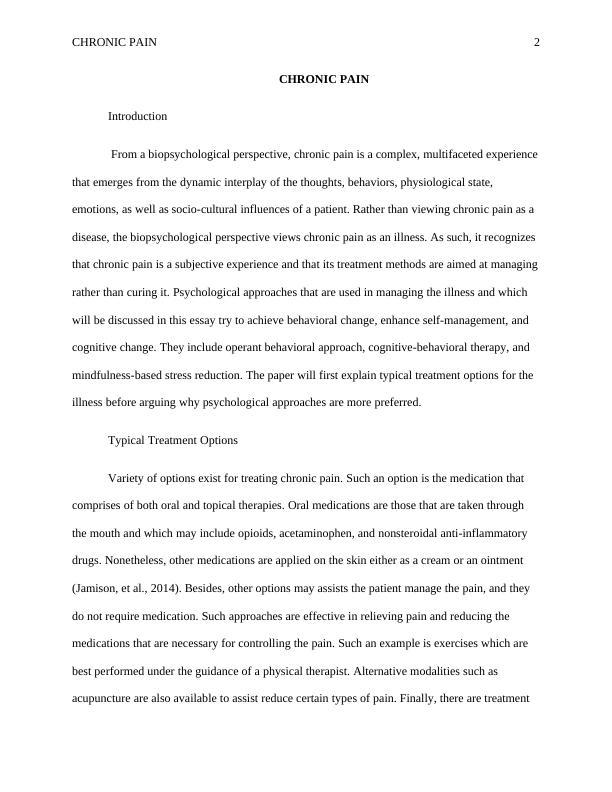Biopsychology of Chronic Pain
Added on 2022-10-14
7 Pages1747 Words206 Views
Running head: CHRONIC PAIN 1
CHRONIC PAIN
Name
Institution
CHRONIC PAIN
Name
Institution

CHRONIC PAIN 2
CHRONIC PAIN
Introduction
From a biopsychological perspective, chronic pain is a complex, multifaceted experience
that emerges from the dynamic interplay of the thoughts, behaviors, physiological state,
emotions, as well as socio-cultural influences of a patient. Rather than viewing chronic pain as a
disease, the biopsychological perspective views chronic pain as an illness. As such, it recognizes
that chronic pain is a subjective experience and that its treatment methods are aimed at managing
rather than curing it. Psychological approaches that are used in managing the illness and which
will be discussed in this essay try to achieve behavioral change, enhance self-management, and
cognitive change. They include operant behavioral approach, cognitive-behavioral therapy, and
mindfulness-based stress reduction. The paper will first explain typical treatment options for the
illness before arguing why psychological approaches are more preferred.
Typical Treatment Options
Variety of options exist for treating chronic pain. Such an option is the medication that
comprises of both oral and topical therapies. Oral medications are those that are taken through
the mouth and which may include opioids, acetaminophen, and nonsteroidal anti-inflammatory
drugs. Nonetheless, other medications are applied on the skin either as a cream or an ointment
(Jamison, et al., 2014). Besides, other options may assists the patient manage the pain, and they
do not require medication. Such approaches are effective in relieving pain and reducing the
medications that are necessary for controlling the pain. Such an example is exercises which are
best performed under the guidance of a physical therapist. Alternative modalities such as
acupuncture are also available to assist reduce certain types of pain. Finally, there are treatment
CHRONIC PAIN
Introduction
From a biopsychological perspective, chronic pain is a complex, multifaceted experience
that emerges from the dynamic interplay of the thoughts, behaviors, physiological state,
emotions, as well as socio-cultural influences of a patient. Rather than viewing chronic pain as a
disease, the biopsychological perspective views chronic pain as an illness. As such, it recognizes
that chronic pain is a subjective experience and that its treatment methods are aimed at managing
rather than curing it. Psychological approaches that are used in managing the illness and which
will be discussed in this essay try to achieve behavioral change, enhance self-management, and
cognitive change. They include operant behavioral approach, cognitive-behavioral therapy, and
mindfulness-based stress reduction. The paper will first explain typical treatment options for the
illness before arguing why psychological approaches are more preferred.
Typical Treatment Options
Variety of options exist for treating chronic pain. Such an option is the medication that
comprises of both oral and topical therapies. Oral medications are those that are taken through
the mouth and which may include opioids, acetaminophen, and nonsteroidal anti-inflammatory
drugs. Nonetheless, other medications are applied on the skin either as a cream or an ointment
(Jamison, et al., 2014). Besides, other options may assists the patient manage the pain, and they
do not require medication. Such approaches are effective in relieving pain and reducing the
medications that are necessary for controlling the pain. Such an example is exercises which are
best performed under the guidance of a physical therapist. Alternative modalities such as
acupuncture are also available to assist reduce certain types of pain. Finally, there are treatment

CHRONIC PAIN 3
options that require injections into or around the spinal region. The method entails relatively
superficial injections to the muscles experiencing pain, commonly known as trigger point
injections. With this type of approach, several procedures may include epidural injections for the
type of pain involving the legs, arm, back, and neck. It may also include facet injections that are
injected into the joints that allow neck movement and back injections for pain mainly
experienced on the arms and legs as a result of Complex Regional Pain Syndrome (Keefe, et al.,
2013). Typical treatments are not effective compared to psychological interventions. This is
because high levels of pain still persist on the patient despite being given medications.
Nonetheless, methods such as medication may not apply to patients that do not qualify as
candidates for treatment.
Psychological Approaches
The first approach is the behavioral approach. This type of intervention tries to reward
healthy behaviors and at the same time ignore the unhealthy ones. Behavioral approach
positively reinforces healthy behaviors. Such behaviors include increasing physical activity,
reducing pain intensity, sick leave behavior, as well as symptoms associated with disability.
Other behavioral approaches include relaxation exercises that reduce the mind of painful stimuli.
The second type of psychological approach is cognitive behavior therapy (Gatchel, et al., 2014).
The approach seeks to psycho-educate the patients regarding their conditions as well as the
factors that are likely to cause the pain to increase, including the change maladaptive behavior
and thoughts. Nonetheless, this technique also champions problem-solving, the scheduling of
pleasant events, as well as cognitive reframing. The patients take an active role in the treatment
of chronic pain by setting achievable and realistic goals (Sturgeon, 2014). The third approach is
the mindfulness-based approach. An example of a mindfulness-based approach is the
options that require injections into or around the spinal region. The method entails relatively
superficial injections to the muscles experiencing pain, commonly known as trigger point
injections. With this type of approach, several procedures may include epidural injections for the
type of pain involving the legs, arm, back, and neck. It may also include facet injections that are
injected into the joints that allow neck movement and back injections for pain mainly
experienced on the arms and legs as a result of Complex Regional Pain Syndrome (Keefe, et al.,
2013). Typical treatments are not effective compared to psychological interventions. This is
because high levels of pain still persist on the patient despite being given medications.
Nonetheless, methods such as medication may not apply to patients that do not qualify as
candidates for treatment.
Psychological Approaches
The first approach is the behavioral approach. This type of intervention tries to reward
healthy behaviors and at the same time ignore the unhealthy ones. Behavioral approach
positively reinforces healthy behaviors. Such behaviors include increasing physical activity,
reducing pain intensity, sick leave behavior, as well as symptoms associated with disability.
Other behavioral approaches include relaxation exercises that reduce the mind of painful stimuli.
The second type of psychological approach is cognitive behavior therapy (Gatchel, et al., 2014).
The approach seeks to psycho-educate the patients regarding their conditions as well as the
factors that are likely to cause the pain to increase, including the change maladaptive behavior
and thoughts. Nonetheless, this technique also champions problem-solving, the scheduling of
pleasant events, as well as cognitive reframing. The patients take an active role in the treatment
of chronic pain by setting achievable and realistic goals (Sturgeon, 2014). The third approach is
the mindfulness-based approach. An example of a mindfulness-based approach is the

End of preview
Want to access all the pages? Upload your documents or become a member.
Related Documents
Review of the Clinical Management for Cervical Spondylosislg...
|5
|810
|436
Carpal Tunnel Syndromelg...
|4
|782
|324
Chronic Pain: Nursing Interventions - Evidence Summarylg...
|3
|2062
|294
Strategies for Managing Chronic Diseases in Nursing Practicelg...
|6
|1024
|162
Management of Diabetes Mellituslg...
|11
|3138
|127
Understanding Physical Health Conditionslg...
|11
|3813
|499
